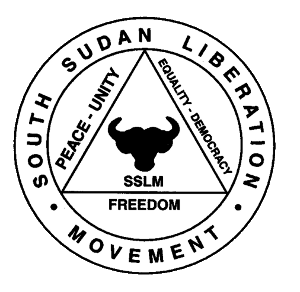
The South Sudan Liberation Movement (SSLM) is an armed group that operates in the Upper Nile Region of South Sudan. The group's creation was announced in November 1999 by people of the Nuer ethnicity who were in both the rebel Sudan People's Liberation Army (SPLA) and the government-allied South Sudan Defence Forces (SSDF) gathered in Waat. The SSLM was declared to be unaligned in the Second Sudanese Civil War, then entering its sixteenth year. The name "South Sudan Liberation Movement" was decided upon the next year, borrowing from the earlier Southern Sudan Liberation Movement, which existed in the 1980s.

Riek Machar Teny Dhurgon is a South Sudanese politician who serves as the first Vice President of South Sudan.

The South Sudan People's Defence Forces (SSPDF), formerly the Sudan People's Liberation Army (SPLA), is the army of the Republic of South Sudan. The SPLA was founded as a guerrilla movement against the government of Sudan in 1983 and was a key participant of the Second Sudanese Civil War, led by John Garang. After Garang's death in 2005, Salva Kiir was named the SPLA's new Commander-in-Chief. As of 2010, the SPLA was divided into divisions of 10,000–14,000 soldiers.
Peter Gatdet Yak or Peter Gadet was a Sudan People's Liberation Army (SPLA) general who became the leader of the South Sudan Liberation Army (SSLA), a rebel movement in South Sudan.

Leer is a town in South Sudan. It is the capital of Southern Liech State and Leer County.
Paulino Matip Nhial, or Matiep Nhial, was a military leader and politician in South Sudan.
The Juba Declaration of 8 January 2006, formally the Juba Declaration on Unity and Integration between the Sudan People’s Liberation Army (SPLA) And the South Sudan Defence Forces (SSDF) 8 January 2006, laid out the basis for unifying rival military forces in South Sudan following the end of the Second Sudanese Civil War in January 2005.
Gordon Kong Chuol is a former militia commander in South Sudan, who fought for the Sudan People's Liberation Army (SPLA) and later for the forces led by Riek Machar during the Second Sudanese Civil War.

Mayom is a community in Unity State of South Sudan to the west of Bentiu. It is the headquarters of Mayom County.

Mayom County is an administrative region in Northern Liech of South Sudan to the west of Bentiu. The county headquarters is Mayom town.
Kerubino Kuanyin Bol was one of the founders of the Sudan People's Liberation Movement (SPLM) and one of the leaders of the Sudan People's Liberation Army (SPLA) during the Second Sudanese Civil War (1983-2005). He was said to have fired the first shot in that conflict, which flared up when the Khartoum government of Sudan imposed Islamic law, or Sharia, across the whole country, including the southern region which in 2011 became the Republic of South Sudan. The people in this region mainly follow the Christianity and/or a traditional animist religion.
Yohannes Yual Both was a leader of the South Sudan Defense Forces whose mobile forces gave the Sudan People's Liberation Army considerable difficulty during the Second Sudanese Civil War (1983–2005).
Tito Biel Chuor was a high-ranking commander in the South Sudan Defense Forces (SSDF) during the Second Sudanese Civil War (1983–2005).

Fangak is a community in South Sudan. It lies in Fangak County in Jonglei state. The capital is Old Fanguk. It was once a British garrison town. The administration buildings were destroyed during the civil war.

Block 5A is an oil concession in South Sudan. After oil field development began during the Second Sudanese Civil War, Block 5A was the scene of extensive fighting as rival militias struggled for control. Out of an original population of 240,000, an estimated 12,000 were killed or died of starvation and 160,000 were displaced by force. Production started in 2006. There is evidence that the environmentally sensitive marshlands beside the Nile are becoming polluted. European companies have been accused of complicity in clearance of the population from the oil field.

Koch is a community in Unity State, South Sudan, headquarters of Koch County.

Nhialdiu is a large village in Unity State, South Sudan, about 40 kilometres (25 mi) to the southwest of Bentiu.

Duar is a large village in Koch County, Unity State, South Sudan. It is on the main oil road leading south from Bentiu, and is close to the Thar Jath Central Processing Facility in the Block 5A oil concession.
Peter Par Jiek was a brigadier general of the Sudan People's Liberation Army (SPLA), and veteran of the Second Sudanese Civil War. In the course of that conflict, Par fought under Riek Machar with several rebel and pro-government groups, and eventually became a powerful militia commander in Unity State. In that region, he established his own fiefdom and gained some notoriety for his rivalry with another rebel leader, Peter Gadet. Even though he had followed Machar during the whole Second Sudanese Civil War until 2005, Par sided with President Salva Kiir Mayardit upon the outbreak of the South Sudanese Civil War in 2013. Leading pro-government counter-insurgency forces in Wau State since 2014, Par was eventually ambushed and killed by SPLM-IO rebels loyal to Machar in 2017.

The War of the Peters was a conflict primarily fought between the forces of Peter Par Jiek and Peter Gadet from June 2000 to August 2001 in Unity State, Sudan. Though both were leaders of local branches of larger rebel groups that were involved in the Second Sudanese Civil War, the confrontation between the two commanders was essentially a private war. As Par and Gadet battled each other, the Sudanese government exploited the inter-rebel conflict as part of a divide and rule-strategy, aimed at weakening the rebellion at large and allowing for the extraction of valuable oil in Unity State. In the end, Gadet and Par reconciled when their respective superiors agreed to merge the SPDF and SPLA.






